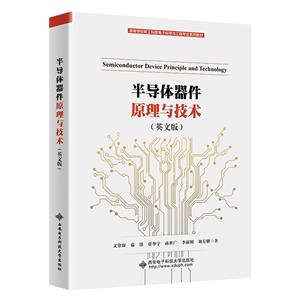-
>
公路车宝典(ZINN的公路车维修与保养秘籍)
-
>
晶体管电路设计(下)
-
>
基于个性化设计策略的智能交通系统关键技术
-
>
花样百出:贵州少数民族图案填色
-
>
山东教育出版社有限公司技术转移与技术创新历史丛书中国高等技术教育的苏化(1949—1961)以北京地区为中心
-
>
铁路机车概要.交流传动内燃.电力机车
-
>
利维坦的道德困境:早期现代政治哲学的问题与脉络
半导体器件原理与技术 版权信息
- ISBN:9787560666204
- 条形码:9787560666204 ; 978-7-5606-6620-4
- 装帧:一般胶版纸
- 册数:暂无
- 重量:暂无
- 所属分类:>>
半导体器件原理与技术 内容简介
This book comprehensively and deeply introduces the semiconductor device principle and technology. The book consists of three sections: semiconductor physics and devices, semiconductor manufacturing process and semiconductor packaging,testing and simulating. The first section mainly introduces semiconductor physics foundation, diode, bipolar junction transistor, MOS field effect transistor, power MOSFET, thyristor, IGBT, passive device and SPICE model. The second section mainly introduces semiconductor process technology, semiconductor process simulation and film preparation technology. The third section mainly introduces semiconductor packaging, testing and simulating technology. These contents will lay a solid foundation for further mastering the basic theories and methods of analysis, design, manufacturing, packaging and testing of semiconductor devices. This book can be used as a textbook for undergraduate and graduate students who are engaged in the analysis, design, manufacturing, packaging and testing of semiconductor devices and IC design. It can also be used as a selfstudy and reference book for professional engineers.
半导体器件原理与技术 目录
- >
我与地坛
我与地坛
¥16.4¥28.0 - >
莉莉和章鱼
莉莉和章鱼
¥14.4¥42.0 - >
中国历史的瞬间
中国历史的瞬间
¥16.7¥38.0 - >
姑妈的宝刀
姑妈的宝刀
¥15.7¥30.0 - >
大红狗在马戏团-大红狗克里弗-助人
大红狗在马戏团-大红狗克里弗-助人
¥5.2¥10.0 - >
罗曼·罗兰读书随笔-精装
罗曼·罗兰读书随笔-精装
¥32.9¥58.0 - >
龙榆生:词曲概论/大家小书
龙榆生:词曲概论/大家小书
¥8.7¥24.0 - >
有舍有得是人生
有舍有得是人生
¥25.7¥45.0
-
电机与电气控制技术
¥27.9¥49 -
电工电子技术及应用(第2版)
¥20.5¥39.8 -
通信原理简明教程
¥10.8¥28 -
电子产品工艺
¥23.4¥66 -
配电实用技术 第4版
¥65.3¥99 -
新能源科学与工程应用丛书光伏发电原理.技术及其应用
¥45.9¥69
复张量优化及其在量子信息中的应用
¥59.5¥78.0光学基本原理
¥62.7¥98.0数字通信
¥18.3¥24.0带有通配符和长度约束的模式匹配
¥77.4¥98.0工程设计制图(第二版)
¥32.4¥49.8

















